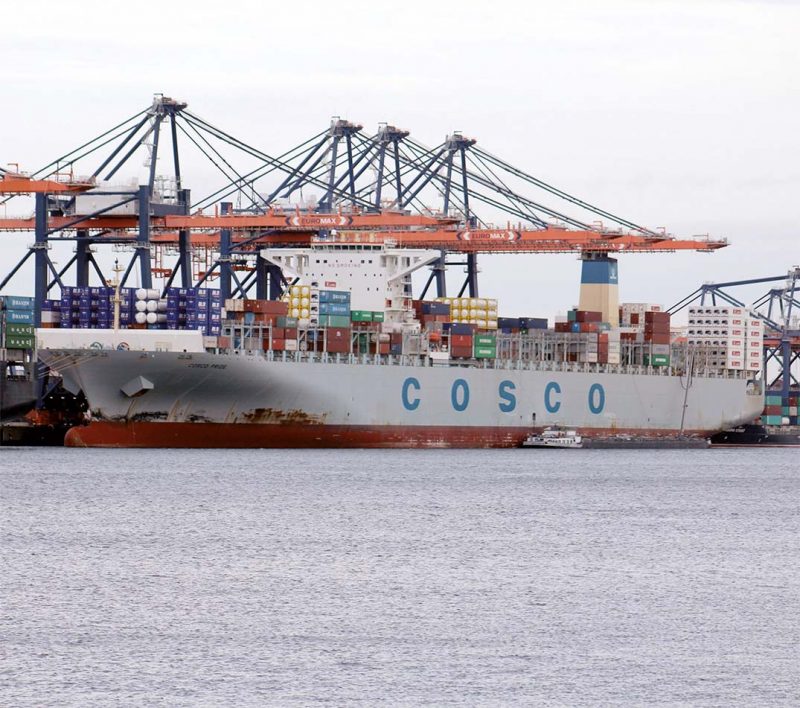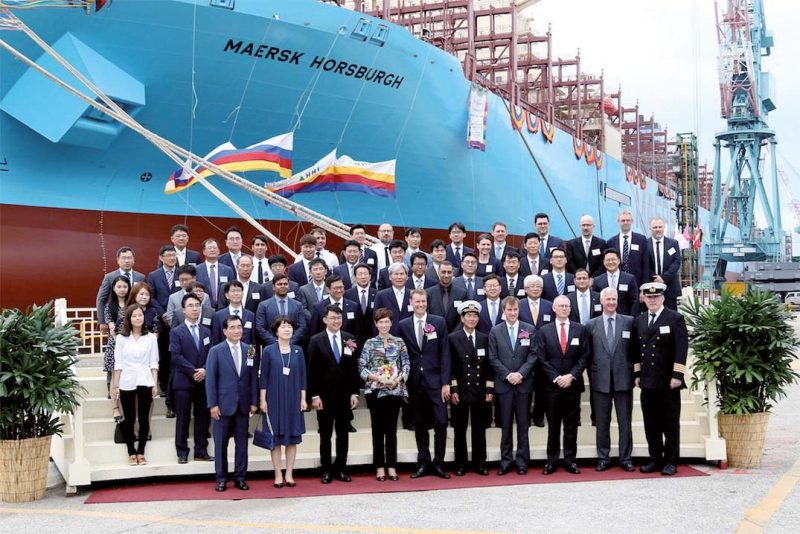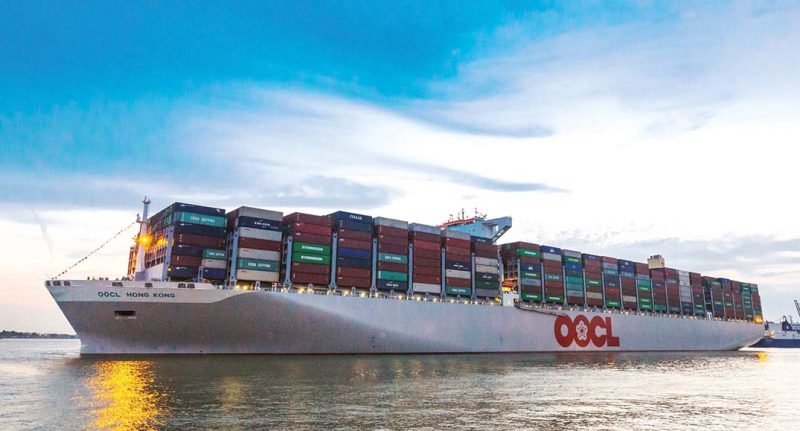APL has been named the ‘Best Shipping Line in the Transpacific’ at the 2017 Asian Freight, Logistics and Supply Chain Awards, in Singapore. Determined through votes cast by industry stakeholders, customers, global shippers and readers of Asia Cargo News, the Award recognises APL as the preferred shipping carrier for the Transpacific market with outstanding leadership, service quality, innovation, customer relationship management and reliability in this segment category.
CMA CGM signed a binding deal with Danish counterpart Maersk Line in June to acquire Mercosul Line that operates in Brazil’s domestic container shipping market. The acquisition of Mercosul Line allows CMA CGM to strengthen its service offering to and from South America, most notably in Brazil, which was seen by the operator as a market with a strong potential for development. The transaction is subject to Brazilian regulatory approval and the closing of Maersk’s Hamburg Süd acquisition. At the earliest, the integration of Mercosul within CMA CGM will start at the same time as the Hamburg Süd integration, which is expected in the fourth quarter of 2017. Until then, Mercosul Line will continue business as usual. Launched in 1996 and acquired by Maersk Line in 2006, Mercosul Line has a fleet of four ships that operate in Brazil and South America. The company employs 92 land based staff and 160 seafarers and reported revenues of $128 million in 2016 and offers strong profitability.
CMA CGM has also purchased the 75,752gt/2010 built and 6,589-TEU Maule for $20.3 million. The ship was constructed by CSBC in Taiwan and previously operated for NYK Line in THE Alliance’s MD3 service between Asia and the Mediterranean.
COSCO’s 141,823gt/2011 built COSCO Pride (above) departed from Felixstowe on the 27th June on a routine sailing to Southampton but suffered an engine failure en-route. She anchored clear of the shipping lanes off Eastbourne for around 36 hours before being towed to the Nab Anchorage off the Isle of Wight by the 484gt/2009 built Smit Tiger. After undergoing repairs, the ship sailed back to Felixstowe late on 3rd July, arriving the next morning before departing again that lunchtime bound for Piraeus. On 16th June Shanghai Waigaoqiao Shipbuilding (SWS) launched the largest containership ever built in China, the 148,386gt/2017 built and 20,000 TEU capacity COSCO Shipping containership Taurus. The ship is 400m long with a beam of 58.6m and is equipped for 1,000 TEU of refrigerated capacity. Stateowned Cosco Shipping ordered a total of eleven 20,000 TEU capacity containerships, of which three are being built by SWS, a subsidiary of China State Shipbuilding Corporation (CSSC). The ship is designed by Waigaoqiao Shipbuilding Company and China Shipbuilding Industry Corporation’s (CSIC) number 80 Research Institute. The previous largest Chinese-built containership was the 18,000 TEU CMA CGM Vasco de Gama delivered in 2015 by Shanghai Jiangnan Changxing Heavy Industry, an affiliate yard of SWS.
Hapag-Lloyd held the naming ceremony for the 118,945gt and 10,500 TEU capacity newbuild Guayaquil Express, the fourth of five newbuildings, at the Altenwerder container terminal in Hamburg on 16th June. Ordered in 2015, the Guayaquil Express will ply between Europe and South America. With a length of 333m and a beam of 48m, the ship is designed for the new locks of the Panama Canal. The ship will operate in the SWX service, calling at Hamburg, Antwerp, Le Havre, Caucedo, Cartagena, Manzanillo/PA, Buenaventura, Callao, Puerto Angamos and Valparaíso. The Guayaquil Express, which was built by Hyundai Samho Heavy Industries in South Korea, and her four sisters are named after ports in South America. Homeported in Hamburg, the ships can carry a maximum of 19 rows of containers side by side on board, which each have a maximum capacity of 123,500 tonnes. The eight cargo holds and decks, offer a total capacity of 10,590 TEU. In July the container operator agreed to sell and lease back eight 8,000 TEU-9,000 TEU containerships to China’s Bocomm Financial Leasing for $320m. All vessels involved are between four and five years old and the deal is part of a $500m strategic agreement signed between the two companies in late June. The leaseback contracts mark the first time that Hamburg-based Hapag-Lloyd has ever borrowed from a Chinese lessor.
Maersk Line was hit by a major cyber-attack at the end of June that affected companies around the world. The attack, which was first noted in Ukraine, hit a number of companies there, including Rosneft, but also reportedly affected global advertising giant WPP, which is based in the UK.
Maersk’s terminals division, APM Terminals, was forced to halt operations at its fully automated Maasvlakte II terminal in Rotterdam, which it blamed on the cyber-attack. Maersk has been at the forefront of shipping’s push towards digitalisation. It takes 98% of its bookings over digital channels and has been a strong proponent of new technologies such as Blockchain. Maersk Line’s 74,642gt/2007 built Maersk Memphis was the centre of a “dirty bomb” threat at the port of Charleston in June. The evacuation order was lifted on 16th June after two days once the four suspect containers had been scanned and cleared by the authorities. The original reporting source of the “threat” was also detained by authorities for further questioning. The vessel was moored at Charleston’s Wando terminal, which was evacuated while law enforcement units from federal, state and local law enforcement agencies investigated the threat. A one nautical mile safety zone was also put in place to cordon off the vessel while authorities carried out checks.
Maersk Line named its new 151,400gt H -Class ship, Maersk Horsburgh, in South Korea in July (above). The ultra large container vessel (ULCV) was built at the Hyundai Heavy Industries shipyard, has a deadweight of 162,100 tons, a length of 353m, a beam of 53.5m and a capacity of 15,226 TEU. The H-Class ships were designed for operational versatility in order to take advantage of shifting trade patterns. The greater capacity allows them to efficiently serve on the East-West trades, while the vessel’s smaller size means these ships are also capable of calling at what are typically smaller ports on the North-South trades, offering some operational versatility.
MPC Container Ships has acquired the 27,971gt/2006 built and 2,742 TEU capacity Stadt Dresden from Germany’s Ahrenkiel Steamship. The latter company will remain the technical ship manager while the commercial management of the vessel will be handled by Contchart. The ship will be re-named AS Clara upon redelivery from the current charter.
MSC has advised, following the insolvency of the Rickmers Group, that it has three vessels from the ailing company under time charter, namely the 21,971gt/2005 built John Rickmers, 14,290gt/2002 built Sandy Rickmers and the 51,364gt/2005 built MSC Florida. The latter two vessels are scheduled for redelivery to the Rickmers Group in September 2017.

Ocean Alliance has switched its Doha call to the Port of Sohar in Oman following sanctions against Qatar. The Ocean Alliance, comprising CMA CGM, Cosco, Evergreen and Orient Overseas Container Line (OOCL), has temporarily halted calls at Hamad Port in Doha on its MEA2 service. The first call was reportedly made at Sohar on 7th June by the 109,712gt/2014 built APL Mexico City. Members of the Ocean Alliance will be transhipping cargo to Qatar on Milaha which has launched a new thrice weekly service between Sohar and Qatar in response to the sanctions.
The Ocean Alliance began calling at APM Terminals in Port Elizabeth, New Jersey in June with the first call being made by the CMA CGM Bianca on the US East Coast Loop 3 Service, providing direct service to the U.S. East Coast from ports in China and Southeast Asia. Until recently, container ships calling at the Port of New York & New Jersey were restricted to 5,000-8,000 TEU in size. However, with the opening of the Panama Canal Expansion in 2016, vessels of up to 14,000 TEU capacity can now transit the widened Panama Canal locks, linking US East coast facilities such as APM Terminals Port Elizabeth with the Far East. Larger ship calls (up to 18,000 TEU in capacity) to the Port of New York/New Jersey’s Newark Bay terminals have also been made possible by the raising of the Bayonne Bridge on the channel into Newark Bay, completed on 30th June. The roadbed of the Bayonne Bridge, linking New Jersey with Staten Island, and originally completed in 1932, has now been raised to a height of 65.5m, 19.5m above the bridge’s original 46m vessel passage clearance. The channels of New York and Newark bay have also been deepened to 15.2m to accommodate the larger vessels. The Ocean Alliance consists of COSCO Container Lines, CMA CGM, Evergreen Line and Orient Overseas Container Line.
Ocean Network Express (ONE) members Nippon Yusen Kabushiki Kaisha, Mitsui OSK Lines and Kawasaki Kisen Kaisha were unable to establish their liner shipping joint venture on 1st July as originally scheduled. The three companies said progress was being made towards completing the establishment of the new integrated container shipping business, including terminal operations outside of Japan. The delay was reportedly due to the longerthan- expected process of obtaining approvals from competition authorities in the jurisdictions where the new joint venture will operate. The agreement between the Japanese “Big Three” to merge their container shipping businesses last year was in keeping with an unprecedented round of consolidation and the formation of global alliances among the ocean carrier heavyweights. The three Japanese lines are already members of The Alliance, along with Germany’s Hapag-Lloyd and Taiwan’s Yang Ming Marine.
When officially established, the new alliance will control a fleet with a capacity of 1.4m TEU, or around 7% of the world’s total capacity, ranking it sixth among the global liner shipping operators. ONE’s members finally established their venture on 7th July and the operation is set to commence operations in April 2018. The holding company is located in Tokyo whilst the operating company is Singapore based.
OOCL took on the World’s Largest Container Ship mantle (in terms of capacity) in the form of the 21,413 TEU capacity OOCL Hong Kong (above). The ship made her maiden call at the Hutchison Ports Port of Felixstowe on the evening of 21st June. The call represented a double celebration it also marked the return of OOCL to the UK’s largest container port after a 17 year absence. The 210,890gt, 399.87m long and 58.8m beam ship was christened on 12th May at the Samsung Heavy Industries (SHI) shipyard on Geoje Island. The last time that OOCL set the world record for the largest containership was back in April 2003 with the OOCL Shenzhen, an 8,063 TEU vessel, also built at the SHI shipyard. The OOCL Hong Kong serves the Asia-Europe trade lane on the LL1 service and her port rotation is: Shanghai / Ningbo / Xiamen / Yantian / Singapore / via Suez Canal / Felixstowe / Rotterdam / Gdansk / Wilhelmshaven / Felixstowe / via Suez Canal / Singapore / Yantian / Shanghai in a 77-day round trip. The OOCL Hong Kong arrived at the port of Rotterdam on 23rd June for the first time. The ship is currently the world’s largest containership in terms of capacity (21,413 TEU) but this record is changing hands frequently. On 19th May the 210,678gt/2017 built and 20,170 TEU capacity MOL Triumph called there and she was followed by the then “world’s largest” 214,286gt/2017 built Madrid Maersk (20,568 TEU) on 12th June. Incredibly just over two years ago the 192,237gt/2014 built MSC Oscar headed the list of the largest container ships, but this spring she was relegated from the top three.
After months of speculation and strenuous denials from both companies involved, it was announced on 9th July that China Cosco Shipping Group had finally agreed to acquire up to 100% equity of Orient Overseas (International) Ltd. (OOCL) in a tender offer for a premium price of HK$49.2bn ($6.3bn). Shanghai and Hong Kong-listed Cosco Shipping Holdings, the container shipping sector of the state-owned conglomerate, and Shanghai-listed Shanghai Port International Group will act as the joint buyer, via their overseas wholly owned subsidiaries Falkner Global and Shanghai Port Group (SIPG). Cosco Shipping acquired a 15% stake in SIPG during June and both parties agreed to acquire at least 68.7% equity in OOIL, which is the amount held by the company’s majority shareholders, the Tung family. CSH will buy a 58.8% stake in OOIL, while SIPG will purchase 9.9%. The remaining shares will be acquired by CSH. The Bank of China will offer a $6.5bn bridge loan to support the deal. As is the norm for such transactions, the takeover will be dependent on approvals from the Chinese government, competitions authorities in China, the EU and the USA, as well as CSH shareholders.
The deal will boost China Cosco Shipping Group’s fleet capacity to 2.4m TEU, surpassing its Ocean Alliance partner CMA CGM to become the world’s third-largest carrier. The OOCL brand will remain and the company will continue to trade without interruption.
Rickmers Trust Management, the financially embattled Singapore-based trustee-manager of Rickmers Maritime received approval from the HSH syndicate, comprising HSH Nordbank and DBS Bank, for the sale of the remaining nine of fourteen vessels to Navios Partners Containers and Navios Partners Containers Finance for $54m, to be completed on 12th July. The proceeds from the sale of these vessels will be paid in full to the HSH syndicate as part settlement of their loan.
SM Line of South Korea is busy with fleet expansion plans as it sets sights on adding nine more ships by the end of 2017. The new ships will be deployed on the new intra-Asian and trans-Pacific routes.
SM LIne plans to acquire five 8,500 TEU and four 5,000 TEU capacity containerships by the end of this year. The 8,500 TEU ships are intended for a new Pacific Northwest service, while their smaller counterparts would be deployed on a new US East Coast service, both set to launch in 2018. The announced acquisitions, once completed, will push the company’s fleet to 26 vessels
ZIM of Israel has deployed the 112,836gt and 11,000 TEU capacity newbuilding Cape Sounio on its Asia South America East Coast (ASE) service in response to the growing market needs. The vessel embarked on her maiden voyage from Busan, South Korea, on 4th May, calling at ports in Brazil, Uruguay, Argentina and Asia. Built at the Hanjin Subic shipyard in the Philippines and delivered in April 2017, the Cape Sounio is the largest vessel to serve in this line and the largest currently employed by ZIM. With a deadweight of 134,900 tons, the ship is 330m long with a beam of 48.2m. The Cape Sounio is owned by Greek shipowner Costamare and chartered to ZIM until April 2018.

The port rotation of the ASE service is as follows: Busan, Qingdao, Shanghai, Ningbo, Chiwan, Singapore, Port Klang, Itaguai, Santos, Paranagua, Buenos Aires, Montevideo, Rio Grande, Navegantes, Itapoa, Santos, Itaguai, Port Klang, Singapore, Hong Kong, Busan.






Comments
Sorry, comments are closed for this item